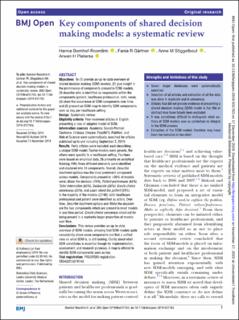| dc.identifier.citation | Bomhof-Roordink, H., Gartner, F.R., Stiggelbout, A.M. & Pieterse, A.H. (2019). Key components of shared decision making models: a systematic review. BMJ Journals, 19(12). | en_US |
| dc.description.abstract | Objectives To (1) provide an up-to-date overview of shared decision making (SDM)-models, (2) give insight in the prominence of components present in SDM-models, (3) describe who is identified as responsible within the components (patient, healthcare professional, both, none), (4) show the occurrence of SDM-components over time, and (5) present an SDM-map to identify SDM-components seen as key, per healthcare setting.
Design Systematic review.
Eligibility criteria Peer-reviewed articles in English presenting a new or adapted model of SDM.
Information sources Academic Search Premier, Cochrane, Embase, Emcare, PsycINFO, PubMed, and Web of Science were systematically searched for articles published up to and including September 2, 2019.
Results Forty articles were included, each describing a unique SDM-model. Twelve models were generic, the others were specific to a healthcare setting. Fourteen were based on empirical data, 26 primarily on analytical thinking. Fifty-three different elements were identified and clustered into 24 components. Overall, Describe treatment options was the most prominent component across models. Components present in >50% of models were: Make the decision (75%), Patient preferences (65%), Tailor information (65%), Deliberate (58%), Create choice awareness (55%), and Learn about the patient (53%). In the majority of the models (27/40), both healthcare professional and patient were identified as actors. Over time, Describe treatment options and Make the decision are the two components which are present in most models in any time period. Create choice awareness stood out for being present in a markedly larger proportion of models over time.
Conclusions This review provides an up-to-date overview of SDM-models, showing that SDM-models quite consistently share some components but that a unified view on what SDM is, is still lacking. Clarity about what SDM constitutes is essential though for implementation, assessment, and research purposes. A map is offered to identify SDM-components seen as key.
Trial registration PROSPERO registration CRD42015019740 | en_US |

